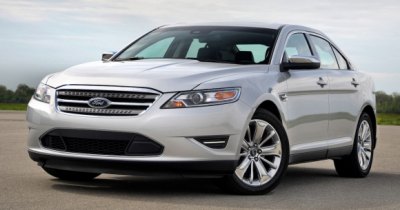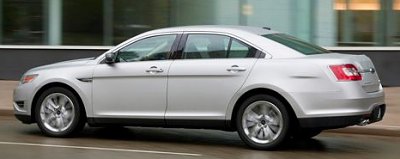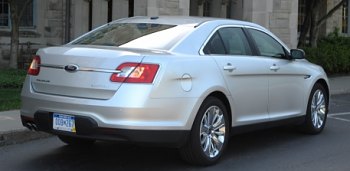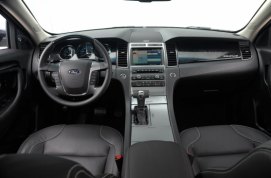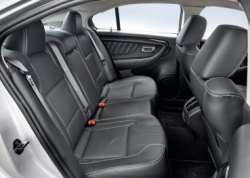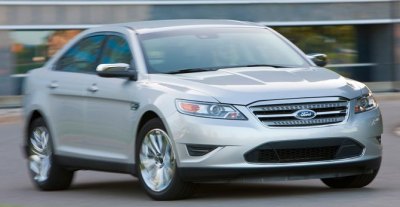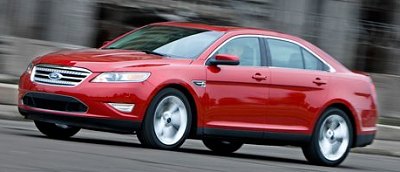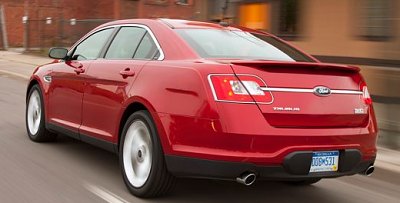Ford Taurus
Debut: 2009 |
|||||||||||
At the first glance, the new Ford Taurus looks fresh. Having abandoned the Volkswagen-Passat-copycat appearance of the old car, its new styling is by all means original. The emphasize here is solidity, which is as apparent as a solid gold brick. Subtle details are carefully treated too, such as the new interpretation of 3-bar corporate grille, the slim headlamps, the silver-crowned taillights, the chromed horizontal bar on the boot lid and a subtle "Lincoln-blade" recessed at each side of the tail. For the first time since the original 1986 car, you can use the word "elegant" to describe the Taurus. Nevertheless, this car has a very big difference from the original - while the latter looked like a European car, the new Taurus feels purely American. Its combination of high waistline, low roof line and slim glass area contribute to a muscular stance close to Chrysler 300C and not available in any other foreign designs. Ford obviously sees the importance of emphasizing its American origin in order to distinguish itself from foreign brands. Its homegrown genes are also reflected in its massive size - at 5.15 meters long and 1.94 meters wide, the new Taurus is one or two size larger than your Camry. In fact, Ford uses it to replace both the old Taurus and the long-serving dinosaur Crown Victoria (and Mercury Grand Marquis).
That bring us to a question: is the new Taurus really a successor to the traditional Taurus line? I'm afraid not. At best we can say it is the successor of the last generation, Five-Hundred-renamed Taurus. Remember the original Taurus occupied the bulk of the American family car market and rivaled Honda Accord and Toyota Camry to the top spot? Unfortunately, its radical redesign in 1996 was not successful, leading to its gradual sales decline over the next decade. In 2004, Ford called the end of the Taurus line and replaced it with two models - the smaller Fusion and the larger Five-Hundred. The latter was derived from the European EUCD platform of Volvo S80 and Ford Mondeo. J. Mays disastrously approved a half-done Volkswagen Passat-like design. Besides, an underpowered old engine in the heavyweight car resulted in poor performance. Build quality and handling were also below class standard. As a result, the Five-Hundred destined to failure from day one. In 2007, it was given a facelift and engine upgrade. At the same time, Ford boss Alan Mulally thought renaming the car into Taurus could improve its image and boost sales, so the Taurus name was reborn on a much larger car. Another decision Mulally made was to push forward the introduction of new generation Taurus. Nevertheless, to recoup the investment made into the Five-Hundred, especially its 2007 update, the new Taurus has to be built on its platform and share most of its underpinnings. Unfortunately, this also implies it share much the same driving character of the old car as well.
One of the things we disliked about the old car was its high floor level and large ground clearance - designed to accommodate its crossover cousin, Freestyle. This is carried over to the new Taurus. Although the new styling belies its height very well, the roof still sits some 1.54 meter above the ground. You open the door and step "onto" its cabin, sit "onto" its high-mounted chair - although it is already lowered by 40mm compared with the last car, it is still higher than conventional cars by the same amount. Some American drivers may enjoy the commanding view over the road ahead, but keener drivers will dislike its sense of high center of gravity. Another carried-over weakness is its bulkiness. We didn't have problems with the EUCD platform in the case of Volvo S80 and Ford Mondeo - the latter is actually excellent - but what if you load it to 1820 kilograms, adding extra metal at both ends and raising its center of gravity? It means lots of understeer when you push it into a bend. The driving experience in Taurus is not about agility or fun. Although its body roll is reasonably well controlled, its chassis dynamics does not deliver the response and sharpness of smaller cars. Moreover, its electric power steering lacks feel to inspire the driver. The hefty weight also hampered its braking performance, which is poor by class standard. The same goes for acceleration, even though the combination of 3.5-liter Duratec V6 (with 263hp and 249 lb-ft of torque) and 6-speed automatic transmission is modern enough. Car & Driver and Motor Trend did a good job to mislead us with 0-60 mph in 7 seconds. You may need many serious attempts to repeat that. Expect a second behind its Accord and Camry V6 rivals.
What the big car excels is driving refinement, just like its predecessor. Its long-travel suspensions deliver a smooth and calm ride. In the cabin it feels solid and quiet. While the 6-speed paddle-shift transmission lacks sparkle, it shifts smoothly. Ditto the V6 engine. However, you can say the same to most of its Japanese rivals as well. The cabin of new Taurus is more stylish than expected. Its center console flows smoothly towards a wide and prominent transmission tunnel, both classy and sporty. The "twin-cockpit" dashboard design enhances the style further. Materials and fit and finish are another lift from the old car, now matches its Japanese rivals. The cabin is not as spacious as we expected for a car so large, partly because of the lowered roofline which costs 1-inch headroom to the rear seats, partly due to the high waistline and shallow windows which results in a darker ambience. It can still carry 5 big adults happily, but the sense of limo space is lost. Another downside of the cabin is rear passenger vision. As the "theater" seating of the old car remains, and the roofline is now lowered, rear passenger vision naturally falls onto the windscreen header instead of the road. More generous is the boot, which swallows nearly 600 liters of luggages.
Thanks to its new packaging, the Taurus should be far more desirable than the old car in the eyes of American customers. However, the old wine in the new bottle delivers much the same mediocre performance and dynamics as before, making it less desirable to us than the original Taurus. Moreover, by upping its size and weight to compete with foreign brands from a class below is just a repeat of the old American tricks. It conflicts with the modern values we pursue today, namely, greenness and driver appeal. |
|||||||||||
| The above report was last updated on 18 Jul 2009. All Rights Reserved. |
